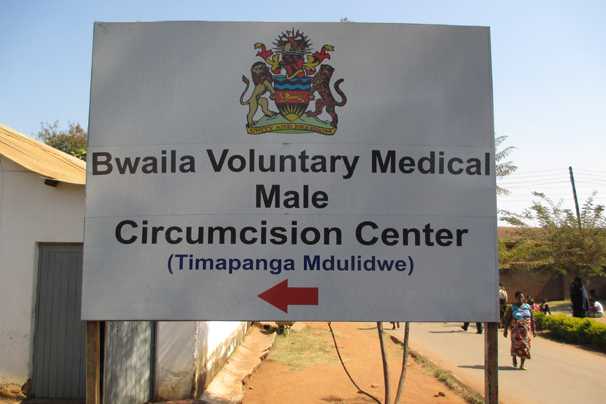Launch of VMMC Activities in Malawi Brings New Tool for HIV Prevention

Bwaila VMMC Center in Lilongwe receives support from CDC through PEPFAR.
Over the past decade, HIV prevalence among adults in Malawi dropped from 16.2% in 1999 to 10.6% in 2010*. Although this success reflects the commitment of the Malawi government and people to ending the HIV epidemic, HIV remains a serious challenge, with nearly one million people living with HIV and limited human, financial, and technical resources to address the epidemic. Reducing the number of new HIV infections in Malawi will require new strategies as well as new resources.
Medically Trained Practitioners
In 2007, the World Health Organization (WHO) recommended inclusion of VMMC in the national HIV prevention plans in high-risk countries such as Malawi. Male circumcision has been scientifically shown to be up to 60% effective in preventing HIV infection in males who are exposed through intercourse with HIV-positive female partners. When combined with other HIV preventive strategies, including condom use, VMMC is an important tool in achieving an AIDS-free generation in Malawi.
Male circumcision is not new to Malawi, as traditional circumcision is performed among several of Malawi’s ethnic groups as part of initiation ceremonies for young men (particularly among the Yao and Lhomwe from the southern region of the country). Only a small portion of Malawi men have undergone traditional circumcision, which may lack the health benefits of circumcisions performed by medically trained practitioners, because traditional procedures are believed to be mostly partial circumcisions, where not all the foreskin is removed.
One function of the MOH media campaign was to teach men that the HIV prevention benefits of circumcision only apply when the entire foreskin is removed. The Malawi MOH also conducted educational and buy-in meetings with traditional, religious, and political leaders to encourage integrating VMMC into traditional practices to ensure safety and hygiene.
VMMC campaign launched
Fortunately, the launch of a new, nationwide voluntary medical male circumcision (VMMC) effort added an important new tool to Malawi’s HIV prevention activities. In July and August 2013, the Malawi Ministry of Health (MOH) kicked off their first ever, 30-day national mass-media campaign to introduce VMMC services.
The campaign was funded by CDC through the U.S. President’s Emergency Plan for AIDS Relief (PEPFAR), in collaboration with CDC’s VMMC implementing partners, I-TECH, Christian Health Association of Malawi, and Malawi AIDS Counseling and Resource Organization, as well as other PEPFAR partners funded through the U. S. Agency for International Development (USAID) and the U.S. Department of Defense. The goal of the MOH VMMC campaign was to circumcise 60,000 men between the ages of 15 and 49 in six priority districts out of Malawi’s 28 districts: Blantyre, Lilongwe, Mulanje, Nkhotakota, Phalombe, and Thyolo. I-TECH, working in Lilongwe District, reported 6,141 men registered for VMMC in August, of whom 5,830 were circumcised. In the previous month, the same district had recorded 1,939 VMMC procedures. This increase in service is attributed to the national media campaign and the awareness it brought to men and women about the importance of VMMC in preventing HIV. Overall, 40,089 men were circumcised during the 30-day campaign, representing 67% achievement of the campaign goal.
Expanding VMMC activities
CDC has been a key partner in expanding VMMC in countries like Malawi, where HIV prevalence is high and medical male circumcision is uncommon. In addition to supporting the media campaign, CDC provides ongoing financial and technical support to the MOH to expand its VMMC efforts, and, through partners, has helped establish VMMC service centers. An example is the Bwaila VMMC Center, located in the nation’s capital, Lilongwe, which opened in September 2012 in partnership with ITECH, the Lilongwe District Health Office, and the MOH.
As efforts to mobilize uptake of VMMC across the nation continue, the MOH and implementing partners will build on lessons learned during the campaign, with identification and documentation of ways to improve cost efficiency and maximize impact.
*Malawi National Statistical Office and ICF Macro. 2011. 2010 Malawi Demographic and Health Survey: Key Findings. Calverton, Maryland, USA: NSO and ICF Macro.
Date: 2014
Malawi Country Page
- Page last reviewed: June 17, 2014
- Page last updated: June 17, 2014
- Content source:


 ShareCompartir
ShareCompartir